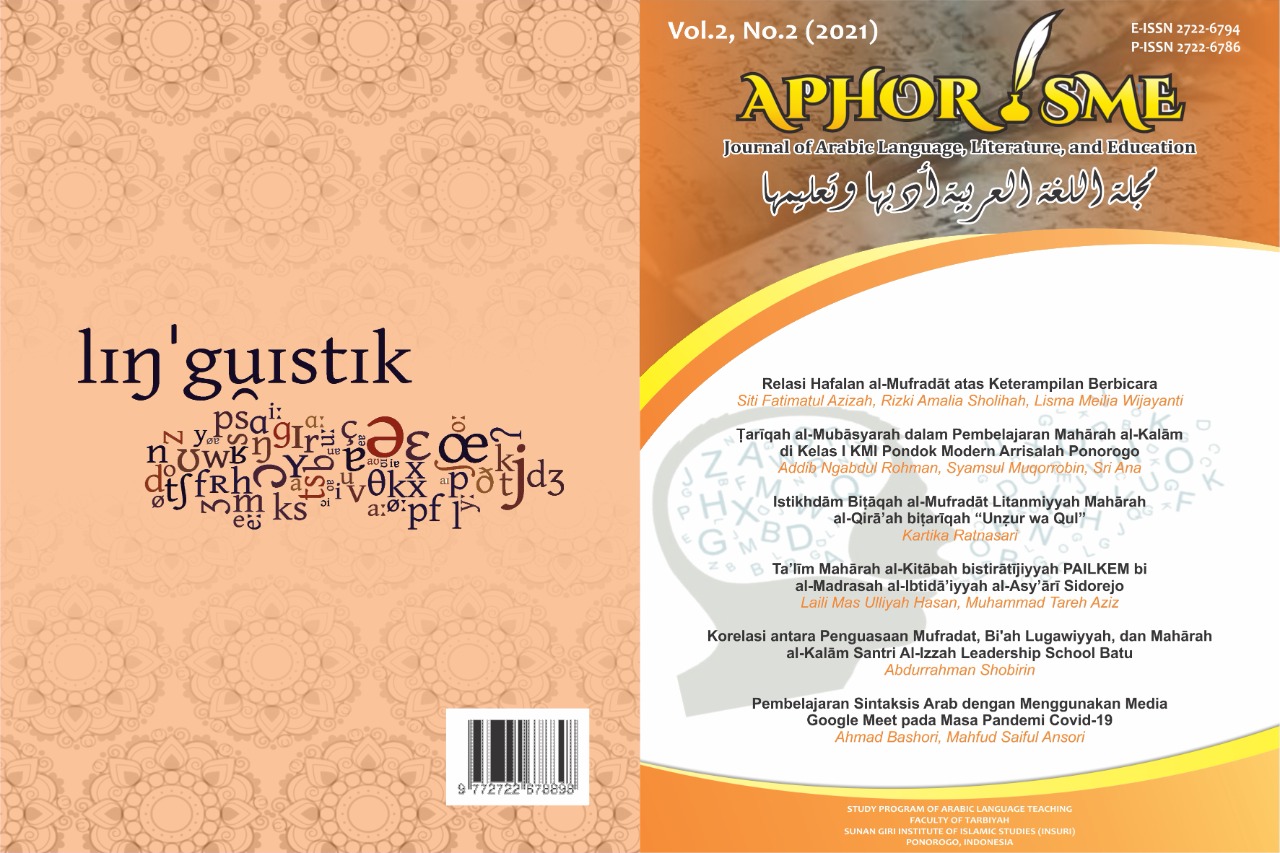Ta’līm Mahārah al-Kitābah bistirātījiyyah PAILKEM bi al-Madrasah al-Ibtidā’iyyah al-Asy’ārī Sidorejo
Teaching and Learning Arabic Writing Skills Using the PAILKEM Approach at Madrasah Ibtidaiyah al-Asy'arie Sidorejo
DOI:
https://doi.org/10.37680/aphorisme.v2i2.912Keywords:
Language Teaching Strategies, PAILKEM Strategies, Teaching Writing SkillsAbstract
The research problem are the students’ low writing skills in Arabic subjects and the teaching strategies used in the classroom. Hence, the researcher used the PAILKEM strategy with active learning and the Word Square model included in it. The PAILKEM strategy has been modified to become a strategic practice in improving the writing skills of Al-Asy'ari Elementary School pupils. With the PAILKEM strategy, the students become motivated to participate in lessons and the responsibility of the students is higher because the learning is grouped captivatingly but still takes care of the learning objectives that have been set. The results showed that after the PAILKEM strategy implementation, there were significant changes in students' learning, specifically in studying writing skills and developing students' social skills during the teaching process. The teaching activities were also effective.
References
Ben-Naouar, Y. (2021). al-Ta’āysy al-Ṡaqāfī wa al-Ḥaḍārī bi al-Magrib. Aphorisme: Journal of Arabic Language, Literature, and Education, 2(1), 1–12.
Charismiadji, I. (2016). Minat baca Indonesia rendah. Babel Pos.
Fahrurrozi, A. (2014). Pembelajaran bahasa arab: Problematika dan solusinya. Arabiyat: Jurnal Pendidikan Bahasa Arab Dan Kebahasaaraban, 1(2), 161–180. https://doi.org/http://dx.doi.org/10.15408/a.v1i2.1137
Lutfiati, R. R., & Wahyuni, F. (2021). Ta’līm al-Lugah al-‘Arabiyyah bimajāl Mahārah al-Qirā’ah wa al-Kitābah. Aphorisme: Journal of Arabic Language, Literature, and Education, 2(1), 33–46.
Nodyanto, D. (2017). Membangun Budaya Literasi Melalui Strategi PAILKEM (Pembelajaran Aktif, Inovatif, Lingkungan, Kreatif, Efektif dan Menarik. Jurnal Guru Dikmen, 2.
Nufus, H. (2013). Pembelajaran Gramatika Arab dengan Communicative Grammar. Jurnal Studi Islam.
Sa’id, S. (2011). Problematika Pengajaran Menulis dalam Bahasa Arab untuk Pelajar Indonesia dan Upaya Mengatasinya dengan Pendekatan Acuan Linguistik. Jurnal Yogyakarta: Universitas Islam Negeri Sunan Kalijaga Yogyakarta.
Salma, K. N. (2020). تطوير مواد مهارة الاستماع باستخدام الوسائل المتعددة برمجة فلوتاغون ستوري لتلاميذ المدرسة المتوسطة الاسلامية الحكومية الثانية مالانج. Universitas Islam Negeri Maulana Malik Ibrahim.
Setyowati, N. (2020). Problematika Pembelajaran Kitabah dan Tarjamah di Madrasah Ibtidaiyah. Aphorisme: Journal of Arabic Language, Literature, and Education, 1(1), 32–42.
Sobry, M. S. (2014). Metode dan Model-model Pembelajaran Menjadikan Proses Pembelajaran Lebih Variatif, Afektif, Inovatif, Efektif dan Menyenangkan. Holistica.
Sriastuti. dkk. (2014). Meningkatkan Keterampilam Menyusun Teks Laporan Hasil Pengamatan dengan Menggunakan Metode PAILKEM pada Siswa Kelas VII-1 MTsN 2 Kendari. Jurnal Bastra, 4.
Sugiyono. (2013). Metode Penelitian Pendidikan: pendekatan kuantitatif, kualitatif, dan R&D. Alfabeta.
Sujawerni, V. W. (2014). Metodologi Penelitian. PT Pustaka Baru.
Sutaryono, W. I. (2018). Implementasi Pembelajaran Bahasa Jawa Berbasis PAILKEM di Kelas 3 Sekolah Dasar. Joyful Learning Journal, 7.
Uno, H. B. dan N. M. (2011). Belajar dengan Pendekatan PAILKEM. Bumi Aksara.
Zulkarnaini. (2011). Model Kooperatif Tipe Think Talk Write (TTW) untuk Meningkatkan Kemampuan Menulis Karangan Deskripsi dan Berpikir Kritis. Universitas Pendidikan Indonesia.
Downloads
Published
Issue
Section
License
Authors who publish with this journal agree to the following terms:
Authors retain copyright and grant the journal right of first publication with the work simultaneously licensed under a Creative Commons Attribution-NonCommercial 4.0 International License that allows others to share the work with an acknowledgement of the work's authorship and initial publication in this journal.
Authors are able to enter into separate, additional contractual arrangements for the non-exclusive distribution of the journal's published version of the work (e.g., post it to an institutional repository or publish it in a book), with an acknowledgement of its initial publication in this journal.
Authors are permitted and encouraged to post their work online (e.g., in institutional repositories or on their website) prior to and during the submission process, as it can lead to productive exchanges, as well as earlier and greater citation of published work.





.jpg)


1.jpg)
